Numbers Don’t Lie: Is OWL Heading Towards An Ashe Meta?
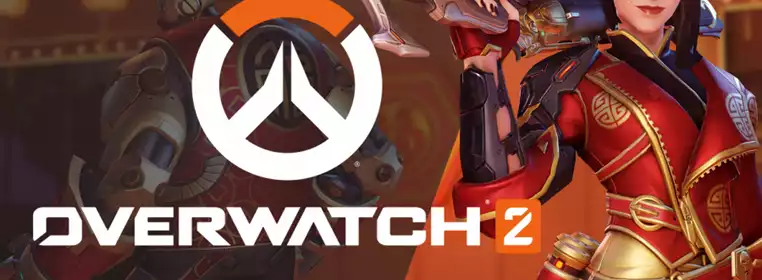
The Overwatch League metagame has pumped its breaks as it coasts into the Midseason Madness. And when the meta begins to slow, there is one DPS pick who seems to always crop up - but funnily enough, we’ve seen her quite a lot already.
Ashe was a more niche hero pick during the Kickoff Clash but one that caught our attention, less about her fixture, or lack thereof, in the meta and more about the health of the hero in a post-5v5 world. With a possible entryway into the Overwatch League as a staple pick and some fascinating statistics to lean on, we’re left wondering - is the Overwatch League heading towards an Ashe metagame?
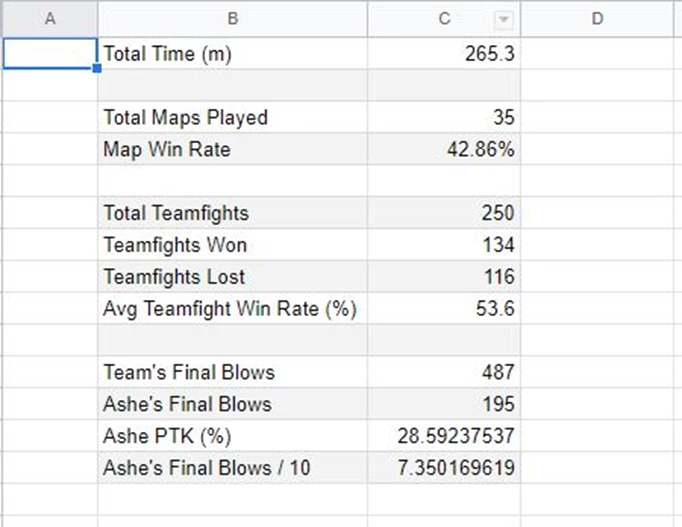
 Click to enlarge
Click to enlarge(DISCLAIMER: The statistics tracked in the Google Sheet linked above were tracked by hand by one person. Expect some level of inaccuracy.)
While this scatter-brained, hand-tracked Google Sheet is no Overwatch League Stats Lab, it still does the job when we want to explore Ashe’s potential within this last metagame and the next.
This go around we attempted to track Ashe’s usage across the whole stage, so there is no time requirement based on the assumption that most players will have around or over ten minutes of playtime across the Kickoff Clash. On top of that, we expanded our insight into where and when she has played to help clarify where Ashe tends to sit within a metagame.
Where Was Ashe Used?
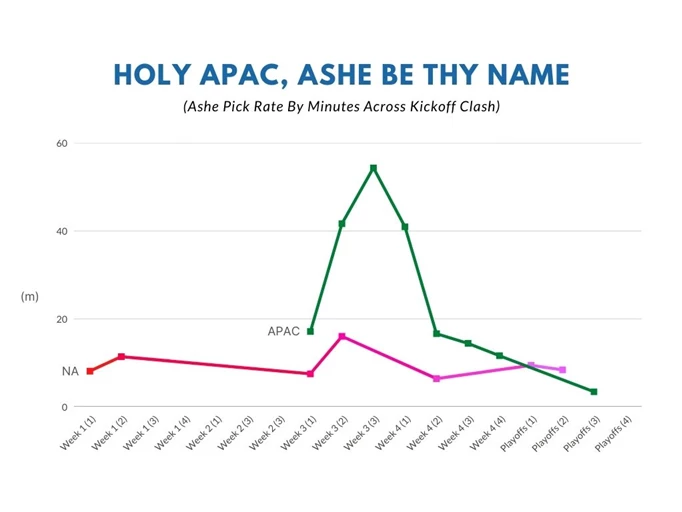
 Click to enlarge
Click to enlargeAPAC dominated the play rate with 74.4% (nearly three and a half hours) of the time played. However, Ashe’s play rate dwindled in the APAC region as the season progressed where Soldier: 76 firmed cemented himself as the go-to hitscan presence by playoffs.
One explanation as to why this is the case could be derived from the compositions each region was more comfortable with. Early on, North America was much more dive centric, with only the Boston Uprising and Dallas Fuel really championing the Zarya composition.
Meanwhile, in APAC, the Zarya composition was featured much more prominently throughout the first few weeks with dive being played a bit less.
One hypothesis could be that Ashe was an answer for the Zarya mirror match-up. This creates a world where teams felt less threatened by flanking DPS and assumed they would be able to find high amounts of value with Dynamite splashing onto the Zarya and possible one or both of her supports. This high sustained damage could force extra resources from the opposing Zarya team, allowing Ashe’s team the upper hand.
And, following the natural flow of the playoffs, with dive becoming more and more prominent (as well as Reinhardt), we see Ashe’s pick rate tapper off towards playoffs for APAC.
To add to this, Soldier: 76 does much of the same job Ashe does in terms of consistent DPS in a hitscan package and seems to do it both more consistently while being safer in the vast majority of maps. Perhaps APAC also caught wind of this which also could explain the steep play time cut by week four’s second day.

 Click to enlarge
Click to enlargePast her maps we see another interesting development; Ashe saw the most success on defensive rounds rather than offensive rounds. This is likely due to her being very focused on controlling the high ground. Defensive rounds intrinsically give teams space and map control to leverage against the attacking team’s hero swap priority and objective control.
Ashe thrives in circumstances where space is given to you inherently rather than having to fight for it - more on this later.
Why Was Ashe Used?
To reiterate, for Kickoff Clash, Ashe was a Soldier: 76 substitutes on longer, more narrow maps. Her pick potential and consistent DPS with Dynamite were interesting selling points however she remained a niche pick, stuck on the maps that allowed her. This lasted until Soldier: 76 really took hold in APAC towards playoffs. However, one of her more subtle aspects that could be leveraged in Overwatch 2, in particular, is her ultimate.
One of the talking points coaches and experts alike have echoed is the difficulty of managing the objective without D.Va. We spoke about "modes" during our dive into Sombra and how each hero has a set of ways or attributes that allow them to solve specific problems. Heroes like Tracer now become incredibly strong because of her ability to operate as a flanking threat in one moment, and in the next, she becomes an added piece to threaten the objective.
Ashe normally does not operate in this way. She plays well within the space created by her tank and can act as a form of peel with Coach Gun in minor circumstances. However, her ultimate provides an interesting solution to the "flex tank" conundrum. Because teams do not have a D.Va or a second high HP target to exist on the objective to either burn time off the clock or progress the objective, B.O.B adds to Ashe’s flexibility, even if momentarily.
There is no other ultimate in the game that can contest an objective. The ability to safely do that is something that cannot be understated.
However, we will be the first to say; B.O.B is not a win condition and we’re hesitant to say this is a selling point. This is a feature more than anything.
To explain, a pick with Pulse Bomb, a Nano Boosted Dragon Blade, and Earthshatter, are all examples of ultimates that instantly impact the kill feed and drive advantages into team fight victories. B.O.B’s ability to contest the objective creates a dynamic where Ashe’s tank player is free to engage directly while the team still has some safe point pressure.
The ability to circumvent the D.Va problem safely, without changing heroes, albeit infrequently, is incredibly valuable. Again, this is not a primary reason she is picked, but an interesting feature to note.
When we explored a few case studies in 2020, we found a few touchstones of why Ashe excels on certain maps. To synthesize, Ashe is looking for maps and points with long sightlines of attack and a strong high ground to anchor. This means maps like Dorado, Watchpoint: Gibraltar and Eichenwalde should feature some sizeable playtime - which they did.
Her use case on Ilios provides good examples to highlight where you should pick her and why. Both Well and Lighthouse have fairly long sightlines and accessible high-ground positions to dominate the most common lanes of attack while also having sight of the objective.
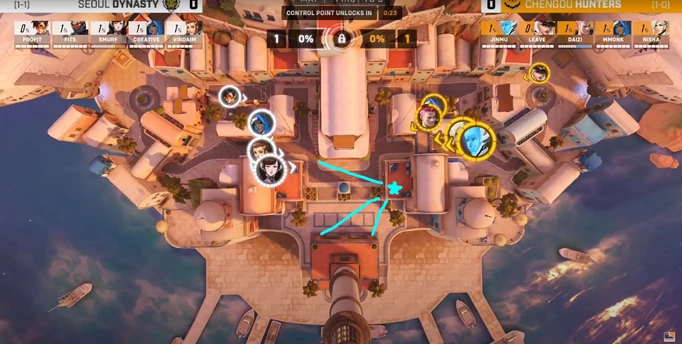
 Click to enlarge
Click to enlargeHere, Leave is able to control the courtyard and the point.
Ruins, for example, checks some of these boxes but remains a fairly flat map. The high ground options for Ashe are more difficult to access due to Coach Gun’s limited jump range and without it, she becomes a very easy target to dive. This is partially why Widowmaker is seen more, if at all. On top of that, we’ve seen teams position properly against Widowmakers to severely limit her usefulness. If Widowmaker has a difficult time working then Ashe will suffer doubly so.
This is also supported by the numbers. From the Kickoff Clash, teams used Ashe nine separate times on Well and six times on Lighthouse.
Yet she was not once used on Ruins.
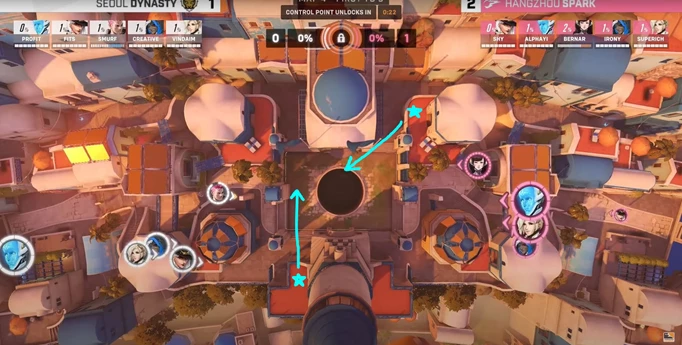
 Click to enlarge
Click to enlargeFits or Shy both could become problems with these positions on Well.
As of week one of the Midseason Madness in North America, we’ve seen a touch of Ashe here and there. New York Excelsior’s Lim "Flora" Young-woo and the Toronto Defiant’s Jeong "Heesu" Hee-su have showcased Ashe on Route 66 and Dorado respectively. Both of which have been tried and tested maps that accentuate Ashe’s strengths rather than hamper them.
One deviation from these norms has emerged during the Midseason Madness.
Kim "Assassin" Sung-won and Choi "MER1T" Tae-min played Ashe against one another on Oasis while Lee "ANS" Seonchang picked it up later in his match against the Paris Eternal. One would think this would be primarily used on sub-maps like City Centre and Gardens, yet both these matches featured a sizeable amount of playtime on University.
Traditionally viewed as a very enclosed and narrow map, drawing Ashe into a phone booth fight doesn’t scream intuitive, does it? Nevertheless, University does feature a strong high ground that is accessible by Ashe alone and that does control both the entryways towards the point. Pair on top of that the decreased amount of Lucio we’ve seen and the picture starts to come together.
If teams, especially support, are rotating slower through these chokes this creates amazing windows for Ashe’s Dynamite, while Coach Gun can be used to create distance from any pesky Wrecking Balls or Doomfists that attempt to dive you. That said, this does stand in opposition to our thoughts on where Ashe succeeds most. Control, as a game mode, does not give either side anything inherently, this means there is no space nor high ground guaranteed.
All of the sub-maps on Oasis mostly meet the criteria for her to be viable, but the symmetrical nature of Control makes it incredibly important for the team with Ashe to win the first fight.
This, to us, signals an increased evaluation of the hero in the current meta.
However, going even further away from the normal script, Jang "Decay" Gui-un’s Ashe on Colosseo left us gobsmacked. This entire map was a great example of Ashe’s potential to guard flanks against Tracer, her ability to play the wings of team fights and also find success on a flank. Again without a Lucio to quickly punish any form of aggressive positions, Decay shows us that Soldier: 76 isn’t the only hitscan that can run around the rim and find a pick from the outside.
However, before we dive too deep into the Midseason and if Ashe becomes a fixture, let’s examine our stand-out performers from the Kickoff Clash.
Who Performed Well On Ashe?
First, we need some statistics to compare. Using older statistics we can compare a player’s participation or the percentage of their team’s kills (PTK). Obviously comparing Overwatch 1 to its sequel isn’t ideal but it’s what we have publicly available.
Using data sets from Winston’s Lab from OGN’s APEX Season 3 and Season 4 we can see that most DPS hold a PTK in the mid-to-upper 20%.
From our data from the Kickoff Clash, Ashe with an average PTK of about 28.59%.
What’s interesting here is that she fits right within what we’ve come to expect out of DPS picks in terms of PTK. With a sense of context established we can rush headlong into some outstanding performers, and boy does someone stick out like a sore thumb.
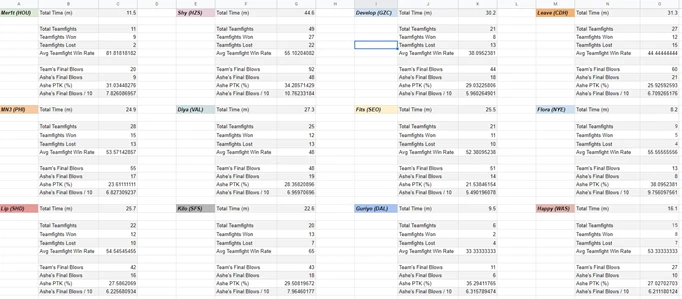
 Click to enlarge
Click to enlarge
From the west two names stick out, those being the San Francisco Shock’s rookie ace Jung "Kilo" Jin-woo and the Houston Outlaws Choi "MER1T" Tae-min.
Kilo’s performance and pedigree in Overwatch Contenders set some high expectations for him, which his Ashe stats tend to support. With nearly 30% PTK and roughly eight kills per ten minutes. Similarly, MER1T carried a lot of expectations that he’s living up to as well. With upwards of 31% PTK and nearly eight kills per ten minutes, MER1T stands as one of the top performers but without much in the way of actual playtime.
However, it’s the APAC region that really provided most of the data. Two of their bright spots being Weida "Diya" Lu of the Los Angeles Valiant and the 2021 MVP Huang "leave" Xin.
Diya performed admirably on Ashe, ending the stage nearly with a 30% PTK and roughly seven kills per ten minutes. Yet what is more impressive is that he was able to hold such good statistics with a sub 50% (~48%) team fight win rate. The same goes for the Chengdu Hunters and leave. The 2021 MVP ended the stage with nearly 26% PTK and 6.7 kills per ten minutes but did so with a 44% team fight win rate on Ashe.
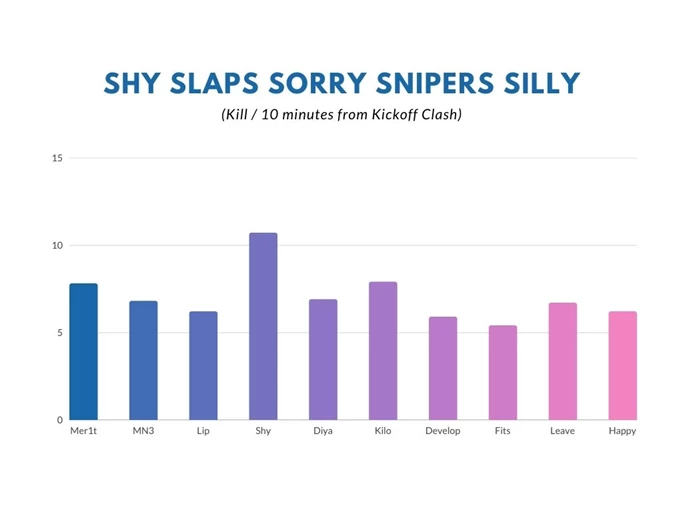
 Click to enlarge
Click to enlargeYet no one really compares to the Hangzhou Spark’s hitscan prodigy, Zheng "shy" Yangjie. Sure he has a considerably higher play rate comparatively and was playing on a winning team, sitting at a 55% team fight win rate, but with a staggering 10.7 kills per ten minutes and around 34% PTK, Shy’s Ashe is a weapon that the Spark can count on.
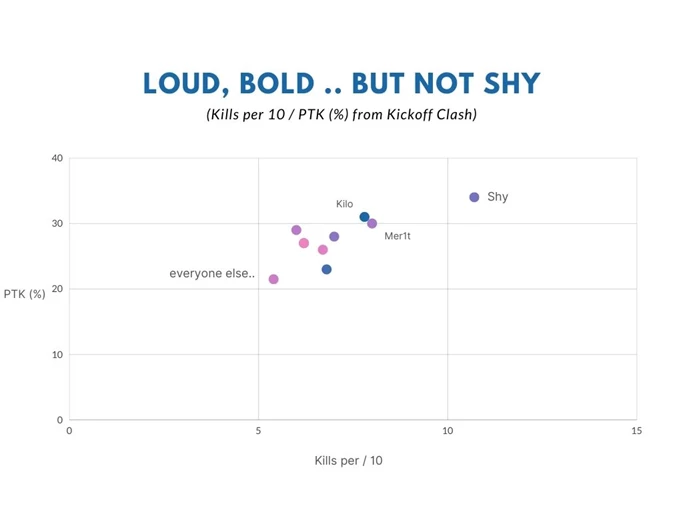
 Click to enlarge
Click to enlargeBy a large margin, Shy was one of, if not, the best Ashe during the Kickoff Clash. That being said, this is an interesting point to where APAC stands within the Midseason Madness meta. With how successful Shy and some of his peers have been and APAC’s favour of the hero, this begs one question.
Will Ashe See Increased Use In The Midseason Madness?
This is a tough stock to sell, but hope isn’t lost for all the B.O.B enthusiasts out there.
With Soldier: 76 stepping out of the metagame, Ashe seemingly should have a great opportunity to see an increase in playtime. However, at least in North America, that has not exactly been the case within week one.
Sojourn, after receiving some significant buffs, seems to now also fill the same niche that Soldier: 76 left which could also impact Ashe’s pick rate this stage. With maps like Midtown, Dorado and Eichenwalde already being strong Ashe maps, we assume that a stylistic development will occur over time to have Ashe become a strong pick on defence while Sojourn is more than likely take precedent on the vast majority of points and leads the pick rate.
However to the Washington Justice’s credit, perhaps the meta develops to include them both.
With the midseason patch comes an increase in both Reinhardt and Sigma as tank fixtures. However, the jury is out on whether or not this is a stylistic choice or the beginning of a more rigid metagame. What this does signal is a slower meta and with that comes more opportunity for Ashe’s Dynamite to see high value, much like our assumption previously as to why she was seen so much in APAC last stage. When teams focus more on stacked positioning, this increases the chance that Dynamite and splashes on multiple targets and provides a high amount of sustained damage across a number of targets while Ashe remains shooting from the high ground.
This also only speaks to one region, and from our data, the region that is seemingly less likely to pick Ashe to begin with. Meaning things really depend on what the APAC region’s metagame looks like. If they roll out with an incredibly slow, Sigma-focused style, then it’s very likely that the possibility of Ashe’s pick rate increase is quite high - even with Sojourn’s changes. Ashe is a pick certain teams already view as a high commodity, so perhaps Sojourn is a harder pick to sell to the teams.
Regardless, the main point still stands; Ashe seems to be viable from what we’re seeing. With the map pool unchanged and a slow trend towards poke creeping into the fold, Ashe has some legs to stand on within Overwatch League Midseason Madness. What’s concerning is the introduction and viability of Sojourn in the current metagame.
With higher mobility, both horizontally and vertically, Sojourn looks to be an incredibly flexible pick with the ability to be very proactive while also still being strong in more defensive positions. With Ashe’s propensity to the latter, this may be a larger conversation entirely, and one that seems all too familiar. Ashe may be able to cause a great deal of area of effect pressure, but if that’s too slow then does she do anything better than her DPS counterparts?
Similarly to Sombra, if Ashe can’t get a word in edge-wise amongst her hitscan DPS peers, does she need a facelift in Overwatch 2? Does she do enough differently, does she provide any meaningful utility to warrant teams to integrate her?
With the ability to solve the D.Va problem, her potential to thrive in a slower metagame without Lucio being a fixture, and punish more styles that promote stacked positioning - we believe the Overwatch League is stepping into an Ashe meta. By the end of Overwatch League’s Midseason Madness, we should have an idea of where Ashe stands in Overwatch 2.